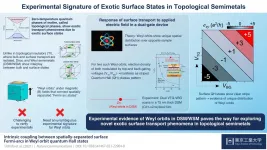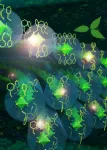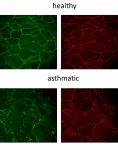Greater effectiveness in the treatment of arrhythmia with radio frequency energy and catheterization
So demonstrates research resulting from the final year project on the bachelor's degree in Biomedical Engineering by Sergi Coderch, supervised by Ana González Suárez and Oscar Camara, researchers with the PhySense research group
2021-05-06
(Press-News.org) An article published in International Journal of Hyperthermia proposes a more effective protocol for the treatment of cardiac arrhythmias when applying radiofrequency energy at the site of the arrhythmia by catheterization. The research results from the final year project (TFG) on the bachelor's degree in Biomedical Engineering by Sergi Coderch Navarro, supervised by Ana González Suárez and Oscar Camara, researchers with the PhySense group of the BCN MedTech Research Unit at the UPF Department of Information and Communication Technologies (DTIC). Sergi Coderch Navarro defended his TFG in July 2019 and was a runner-up in the 2019 Gemma Rossell i Romero Awards. Currently, Ana González Suárez is a postdoctoral researcher at the Translational Medical Device Lab (University College Hospital Galway) within the National University of Ireland Galway.
Eliminating arrhythmias using radiofrequency energy
Cardiac ablation using radiofrequency energy is a minimally invasive procedure used for the elimination of arrhythmias. A catheter is inserted via a vein or an artery in the leg as far as the location of the arrhythmia in the heart. Then, energy is applied via the tip of a catheter so eliminate the arrhythmia just by heating the area. It is important to note that this kind of energy does not cause nerve or muscle stimulation.
During the intervention, clinical complications may arise due to excessive heating of the treatment area. There is no system in the clinical practice to predict or detect them
Although it is a minimally invasive treatment, during the intervention, clinical complications may arise due to excessive heating of the treatment area (exceeding temperatures of 100?C). Currently there is no system in the clinical practice to predict and detect these clinical complications and neither is the optimal protocol for the application of power known (i.e., appropriate power and time to apply the catheter to eliminate the arrhythmia) without causing excessive heating of the treated area.
Complications can be significant. One such complication is known as "steam pops", gas bubbles that form in the heart tissue causing the water in the tissue to turn into gas. These gaseous bubbles can burst, perforating the wall of the heart resulting in the death of the patient.
A mathematical model provides a new, more effective treatment protocol
Current protocols apply low power (20-30 W) over a long period (45-60 s), but a new energy application protocol has emerged recently called high-power in short-duration (HPSD), which applies very high powers (70-90 W) in a short time (4-7 s) to see if it is safer and more effective, i.e., whether it is able to minimize clinical complications while maintaining its effectiveness at eliminating the arrhythmia.
The new HPSD protocol is more effective than conventional ones currently used in the clinical practice to achieve shallower but extensive lesions
In his TFG, Coderch Navarro decided to build a three-dimensional mathematical model that simulates a commercial catheter used in the clinic in order to compare the safety and efficacy of conventional protocols with the new HPSD protocol. "The model has been solved numerically using the finite element method (FEM). The results of the simulations have been validated by experimental studies. Having validated the model, further simulations were carried out to evaluate situations that cannot be assessed (or are practically impossible to assess) experimentally, like for example, taking into account the different positions of the catheter on the tissue", Coderch Navarro explains.
And, the first author of the study adds: "The results suggest that the new HPSD protocol is more effective than the conventional ones currently used in the clinical practice to achieve shallower but extensive lesions, which are optimal for isolating the pulmonary veins and avoiding the risk of damage to the oesophagus".
The authors conclude that this study is a first step to guiding clinicians as to which is the most suitable protocol, depending on the position of the heart arrhythmia and the most appropriate orientation of the catheter. Although there is still a long way to go, this research has responded to one of the hot potatoes in the clinical practice of cardiac radiofrequency ablation.
INFORMATION:
Related work:
Sergi Coderch-Navarro, Enrique Berjano, Oscar Camara, Ana González-Suárez (2021), "High-power short-duration vs. standard radiofrequency cardiac ablation: comparative study based on an in-silico model", International Journal of Hyperthermia, 38:1, 582-592, DOI: 10.1080/02656736.2021.1909148
[Attachments] See images for this press release:

ELSE PRESS RELEASES FROM THIS DATE:
2021-05-06
Scientists at Tokyo Institute of Technology experimentally verify the existence of exotic surface conduction states in topological semimetals (TSMs), materials that lie at the boundary between conductors and insulators, by performing voltage scans of these surface states on a thin film sample of a TSM. The findings can pave the way for future study and exploitation of such conduction states in realizing novel, quantum transport phenomena.
All of us are probably familiar with the idea of conductors and insulators. But what would you call a material that can conduct on the surface but insulate on the inside? Physicists call it a "topological insulator" (TI), a term that highlights the geometric aspect of its strange conduction behavior. Even stranger ...
2021-05-06
ITHACA, N.Y. - Solar-power developers need to explore using lower-quality agricultural land for solar energy, incentivize dual-use (combined agriculture and solar) options, avoid concentrated solar development and engage communities early to achieve New York's green energy goals, according to forthcoming Cornell University research.
"As farmland is generally flat and cleared, agricultural land will be the prime target for future solar energy development," said Max Zhang, professor in the Sibley School of Mechanical and Aerospace Engineering. "Good farmland, however, is not ideal."
Zhang is senior author of "Strategic Land Use Analysis for Solar Energy Development in New York State," which will publish in August 2021 in Renewable Energy.
Under New York state's 2019 Climate ...
2021-05-06
A recent study analyses data collect4d at 44 of the darkest places in the world, including the Canary Island Observatories, to develop the first complete reference method to measure the natural brightness of the night sky using low-cost photometers.
Of the 44 photometers in the survey, the Roque de los Muchachos Observatory (Garafía, La Palma, Canary Islands) stands out at the darkest of all the skies analysed.
The night sky is not completely dark; even in the remotest places there is a glow in the sky produced by natural components, both terrestrial and extraterrestrial, ...
2021-05-06
They are 50,000 times thinner than a human hair, and just a few atoms thick: two-dimensional materials are the thinnest substances it is possible to make today. They have completely new properties and are regarded as the next major step in modern semiconductor technology. In the future they could be used instead of silicon in computer chips, light-emitting diodes and solar cells. Until now, the development of new two-dimensional materials has been limited to structures with layers of rigid chemical bonds in two spatial directions - like a sheet of paper in a stack. Now for the first time, a research team from the ...
2021-05-06
Philadelphia, May 6, 2021--Researchers have found an independent association between COVID-19-related income loss and financial strain and depression, according to the latest study from the COVID-19 Resilience Project, run by the Lifespan Brain Institute (LiBI) of Children's Hospital of Philadelphia (CHOP) and Penn Medicine. This association was found in two separate cohorts - one primarily in the United States and one in Israel - and the depressive symptoms worsened over time in participants who were hit financially, above and beyond pandemic-related anxiety. The findings were published today in the Journal of Affective Disorders.
"This study is an important first step in understanding the unique ...
2021-05-06
(Boston)-- The global spread of COVID-19 has raised serious concern for patients with chronic disease. A correlation has been identified between the severity of COVID-19 and a patient's preexisting comorbidities. Although COVID-19 primarily involves the respiratory system, dysfunction in multiple organ systems is common, particularly in the cardiovascular, gastrointestinal, immune, renal, and nervous systems. Patients with transthyretin amyloidosis (ATTR) (a disease caused by an abnormal misfolded protein that causes buildup of amyloid deposits in the heart, peripheral nervous system including the autonomic nervous system, or other organs) represent a population particularly vulnerable to COVID-19 morbidity due to the multisystem nature of ATTR amyloidosis.
Early ...
2021-05-06
Through a unique combination of computer simulations and laboratory experiments, researchers at the Paul Scherrer Institute PSI have discovered new binding sites for active agents - against cancer, for example - on a vital protein of the cell cytoskeleton. Eleven of the sites hadn't been known before. The study appears today in the journal Angewandte Chemie International Edition.
The protein tubulin is an essential building block of the so-called cell cytoskeleton. In cells, tubulin molecules arrange themselves into tube-like structures, the microtubule filaments. These give cells their shape, aid in transporting proteins and larger cellular components, and play a crucial role in cell division.
Thus tubulin performs diverse functions in the ...
2021-05-06
Like most materials, an elastic band gets thinner when it is stretched. But some materials behave in the opposite way -- they grow thicker when stretched and thinner when compressed. These counterintuitive substances, known as auxetic materials, tend to have a high resistance to shear or fracture and are used in applications such as medical implants and sensors. But typically, this auxetic effect is only seen when the material is distorted in one particular direction.
Now, Minglei Sun and Udo Schwingenschlo?gl have predicted that a group of carbon-based materials, ...
2021-05-06
Epithelial cells form the covering of most internal and external surfaces of the human body. This protective layer acts as a defense against invaders - including bacteria, viruses, environmental toxins, pollutants and allergens. If the skin and mucosal barriers are damaged or leaky, foreign agents such as bacteria can enter into the tissue and cause local, often chronic inflammation. This has both direct and indirect consequences.
Chronic diseases due to defective epithelial barriers
Cezmi Akdis, Director of the Swiss Institute of Allergy and Asthma Research ...
2021-05-06
MIAMI--A new study led by scientists at the University of Miami (UM) Rosenstiel School of Marine and Atmospheric Science tracked large sharks in Miami and The Bahamas to understand how these migratory animals respond to major storms, like hurricanes.
The researchers analyzed acoustic tag data from tiger sharks (Galeocerdo cuvier), bull sharks (Carcharhinus leucas), nurse sharks (Ginglymostoma cirratum), and great hammerheads (Sphyrna mokarran) before, during, and after Hurricane Matthew in 2016 and Hurricane Irma in 2017. They found that they behaved differently by species and location.
For example, in response to ...
LAST 30 PRESS RELEASES:
[Press-News.org] Greater effectiveness in the treatment of arrhythmia with radio frequency energy and catheterization
So demonstrates research resulting from the final year project on the bachelor's degree in Biomedical Engineering by Sergi Coderch, supervised by Ana González Suárez and Oscar Camara, researchers with the PhySense research group







